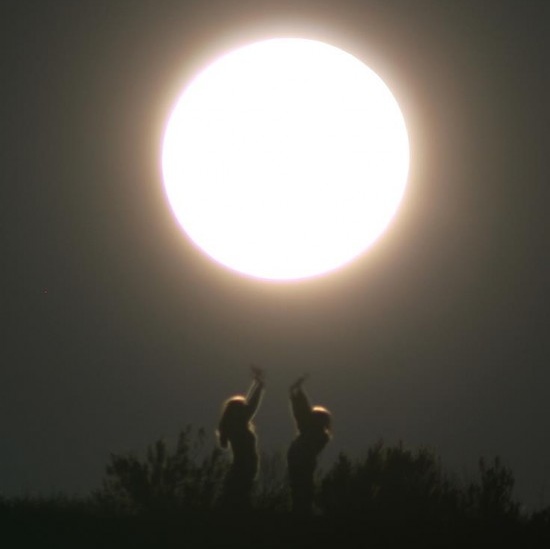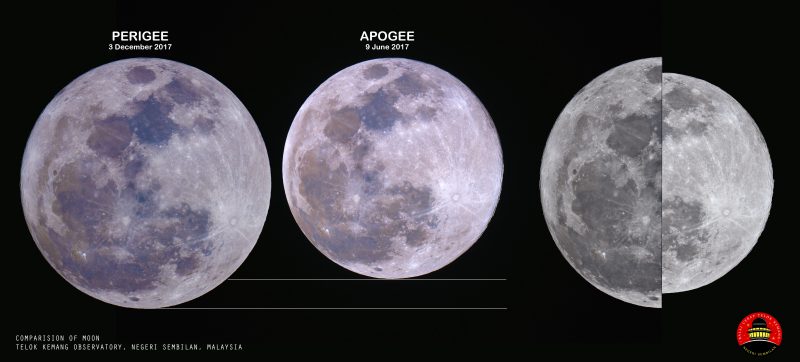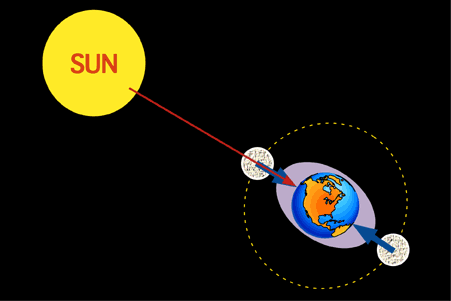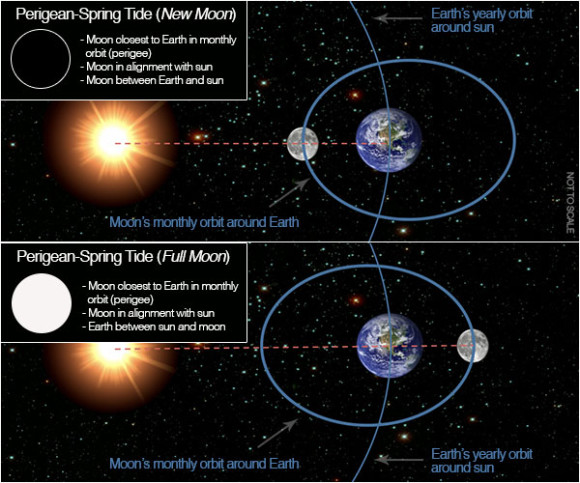
New moon happens when the moon (in its monthly orbit of Earth) goes more or less between the sun and Earth.
Full moon happens when the moon (in its monthly orbit) is on the opposite side of Earth from the sun.
Perigee – from the root words peri meaning near and geo meaning Earth – is the moon’s closest point to Earth in a month.
The new or full moon closely coincides with perigee several times each year. When that happens, in the language of popular culture, we have a supermoon.
As it’s used today, the word supermoon was coined by astrologer Richard Nolle in 1979. According to Nolle’s definition, a full moon or new moon is a supermoon when it’s also within 90% of its closest point to Earth. Nowadays, different websites calculate supermoons differently. EarthSky uses supermoon dates as determined by astronomer Fred Espenak. He’s best known for his time at the Goddard Space Flight Center, where he became a world expert on eclipse predictions. His method of calculating supermoons takes into account changes in the moon’s orbit during each lunar cycle.
Full supermoons in 2022
Fred Espenak’s full supermoon table gives us these values – dates and moon distances – for supermoons in 2022. Contrast these moon distances to the average moon distance of 238,900 miles (384,472 km).
May 16 225,015 miles (362,127 km)
June 14 222,238 miles (357,658 km)
July 13 222,089 miles (357,418 km)
August 12 224,569 miles (361,409 km)
The supermoon of May 16, 2022, will undergo a total lunar eclipse, visible from North America.
The supermoon of July 13 will be the closest supermoon for 2022. On that date, full moon and lunar perigee fall on the same day.
New supermoons in 2022
Fred Espenak does not have a table for new moon supermoons. But we can figure out the dates from other tables on his Astropixels website. We’ll have new supermoons in 2022 on:
January 2 222,478 miles (358,044 km)
February 1 226,493 miles (364,505 km)
December 23 223,702 miles (360,013 km)

Supermoon hype?
Some astronomers complain about the name supermoon. They like to call supermoons hype. But supermoons aren’t hype. They’re special. Many people now know and use the word supermoon. We notice even some diehards are starting to use it now. Such is the power of folklore.
The hype aspect of supermoons probably stemmed from an erroneous impression people had when the word supermoon came into popular usage … maybe a few decades ago? Some people mistakenly believed a full supermoon would look much, much bigger to the eye. It doesn’t. Nowadays, most people seem to realize that supermoons don’t look bigger to the eye than ordinary full moons.
It’s true experienced observers do say they can detect a difference. But you’d have to be a very keen observer to notice it. Most of us can’t tell any difference inthe size of a supermoon and an ordinary full moon
But … do supermoons do look brighter than ordinary full moons? Yes! By a noticeable amount. A supermoon exceeds the disk size and brightness of an average-sized full moon by some 15%. It exceeds the disk size and brightness of a micro-moon (year’s smallest full moon) by some 30%. So go outside on the night of a full supermoon. Even if you’re a casual observer of the moon, there’s the potential for you to notice the supermoon is exceptionally bright!
For a visual reference, the size difference between a supermoon and micro-moon is proportionally similar to that of a U.S. quarter versus a U.S. nickel. Again, that difference isn’t noticeable to the eye at the moon’s distance. But the brightness difference is noticeable.
By the way, before we called them supermoons, we in astronomy called these moons perigean full moons, or perigean new moons. No doubt about it. Supermoon is catchier.

High tides from new and full supermoons
What’s more, all supermoons have the potential to cause higher-than-usual tides. High tides during the full or new moon are called spring tides. High tides during a full or new moon at perigee are called perigean spring tides, or, sometimes, king tides. And nowadays you sometimes hear them called supermoon tides.
These perigean or king or supermoon spring tides tend to follow the date of new or full moon by a day or so. These especially high tides are highly dependent on the shapes of local coastlines and on local weather conditions. They tend to follow the supermoons by a day or so.
Do extra-high supermoon tides cause flooding? Maybe yes and maybe no. Flooding typically occurs when a strong weather system accompanies an especially high spring tide.


How often do we have supermoons?
Often! But it also depends on your definition of supermoon.
Here’s a list of each year’s closest full supermoon perigees from 2010 to 2022 (from Espenak’s full supermoon table):
January 30, 2010 (356,607 km or 221,585 miles)
March 19, 2011 (356,580 km or 221,569 miles)
May 6, 2012 (356,954 km or 221,801 miles)
June 23, 2013 (356,991 km or 221,824 miles)
August 10, 2014 (356,898 km or 221,766 miles)
September 28, 2015 (356,878 km or 221,754 miles)
November 14, 2016 (356,523 km or 221,533 miles)
December 3, 2017 (357,987 km or 222,443 miles)
January 2, 2018 (356,604 km or 221,583 miles)
February 19, 2019 (356,846 km or 221,734 miles)
April 8, 2020 (357,035 km or 221,851 miles)
May 26, 2021 (357,462 km or 222,117 miles)
July 13, 2022 (357,418 km or 222,089 miles)

The recurring cycle of supermoons
The full moon supermoon series of 2022 will recur after 14 lunar months (14 returns to full moon). That’s because 14 returns to full moon almost exactly equal 15 returns to perigee, a period of about one year, one month, and 18 days.
The mean lunar month (full moon to full moon, or new moon to new moon) = 29.53059 days, whereas the mean anomalistic month (perigee to perigee, or apogee to apogee) = 27.55455 days. Hence:
14 lunar months (14 returns to full moon) x 29.53059 days = 413.428 days
15 anomalistic months (15 returns to lunar perigee) x 27.55455 days = 413.318 days
Given that supermoons recur in cycles of 413 days (about one year, one month and 18 days), we can can expect the full moon supermoons to come about one month and 18 days later next year, in 2023.

Bottom line: For 2022, the full moons of May, June, July and August are supermoons. New moon supermoons of 2022 will be the new moons of January, February, and December. The supermoon of July 13, 2022, is the closest and brightest full supermoon of the year.
The post What is a supermoon? And when, in 2022? first appeared on EarthSky.
from EarthSky https://ift.tt/3zfuHYl

New moon happens when the moon (in its monthly orbit of Earth) goes more or less between the sun and Earth.
Full moon happens when the moon (in its monthly orbit) is on the opposite side of Earth from the sun.
Perigee – from the root words peri meaning near and geo meaning Earth – is the moon’s closest point to Earth in a month.
The new or full moon closely coincides with perigee several times each year. When that happens, in the language of popular culture, we have a supermoon.
As it’s used today, the word supermoon was coined by astrologer Richard Nolle in 1979. According to Nolle’s definition, a full moon or new moon is a supermoon when it’s also within 90% of its closest point to Earth. Nowadays, different websites calculate supermoons differently. EarthSky uses supermoon dates as determined by astronomer Fred Espenak. He’s best known for his time at the Goddard Space Flight Center, where he became a world expert on eclipse predictions. His method of calculating supermoons takes into account changes in the moon’s orbit during each lunar cycle.
Full supermoons in 2022
Fred Espenak’s full supermoon table gives us these values – dates and moon distances – for supermoons in 2022. Contrast these moon distances to the average moon distance of 238,900 miles (384,472 km).
May 16 225,015 miles (362,127 km)
June 14 222,238 miles (357,658 km)
July 13 222,089 miles (357,418 km)
August 12 224,569 miles (361,409 km)
The supermoon of May 16, 2022, will undergo a total lunar eclipse, visible from North America.
The supermoon of July 13 will be the closest supermoon for 2022. On that date, full moon and lunar perigee fall on the same day.
New supermoons in 2022
Fred Espenak does not have a table for new moon supermoons. But we can figure out the dates from other tables on his Astropixels website. We’ll have new supermoons in 2022 on:
January 2 222,478 miles (358,044 km)
February 1 226,493 miles (364,505 km)
December 23 223,702 miles (360,013 km)

Supermoon hype?
Some astronomers complain about the name supermoon. They like to call supermoons hype. But supermoons aren’t hype. They’re special. Many people now know and use the word supermoon. We notice even some diehards are starting to use it now. Such is the power of folklore.
The hype aspect of supermoons probably stemmed from an erroneous impression people had when the word supermoon came into popular usage … maybe a few decades ago? Some people mistakenly believed a full supermoon would look much, much bigger to the eye. It doesn’t. Nowadays, most people seem to realize that supermoons don’t look bigger to the eye than ordinary full moons.
It’s true experienced observers do say they can detect a difference. But you’d have to be a very keen observer to notice it. Most of us can’t tell any difference inthe size of a supermoon and an ordinary full moon
But … do supermoons do look brighter than ordinary full moons? Yes! By a noticeable amount. A supermoon exceeds the disk size and brightness of an average-sized full moon by some 15%. It exceeds the disk size and brightness of a micro-moon (year’s smallest full moon) by some 30%. So go outside on the night of a full supermoon. Even if you’re a casual observer of the moon, there’s the potential for you to notice the supermoon is exceptionally bright!
For a visual reference, the size difference between a supermoon and micro-moon is proportionally similar to that of a U.S. quarter versus a U.S. nickel. Again, that difference isn’t noticeable to the eye at the moon’s distance. But the brightness difference is noticeable.
By the way, before we called them supermoons, we in astronomy called these moons perigean full moons, or perigean new moons. No doubt about it. Supermoon is catchier.

High tides from new and full supermoons
What’s more, all supermoons have the potential to cause higher-than-usual tides. High tides during the full or new moon are called spring tides. High tides during a full or new moon at perigee are called perigean spring tides, or, sometimes, king tides. And nowadays you sometimes hear them called supermoon tides.
These perigean or king or supermoon spring tides tend to follow the date of new or full moon by a day or so. These especially high tides are highly dependent on the shapes of local coastlines and on local weather conditions. They tend to follow the supermoons by a day or so.
Do extra-high supermoon tides cause flooding? Maybe yes and maybe no. Flooding typically occurs when a strong weather system accompanies an especially high spring tide.


How often do we have supermoons?
Often! But it also depends on your definition of supermoon.
Here’s a list of each year’s closest full supermoon perigees from 2010 to 2022 (from Espenak’s full supermoon table):
January 30, 2010 (356,607 km or 221,585 miles)
March 19, 2011 (356,580 km or 221,569 miles)
May 6, 2012 (356,954 km or 221,801 miles)
June 23, 2013 (356,991 km or 221,824 miles)
August 10, 2014 (356,898 km or 221,766 miles)
September 28, 2015 (356,878 km or 221,754 miles)
November 14, 2016 (356,523 km or 221,533 miles)
December 3, 2017 (357,987 km or 222,443 miles)
January 2, 2018 (356,604 km or 221,583 miles)
February 19, 2019 (356,846 km or 221,734 miles)
April 8, 2020 (357,035 km or 221,851 miles)
May 26, 2021 (357,462 km or 222,117 miles)
July 13, 2022 (357,418 km or 222,089 miles)

The recurring cycle of supermoons
The full moon supermoon series of 2022 will recur after 14 lunar months (14 returns to full moon). That’s because 14 returns to full moon almost exactly equal 15 returns to perigee, a period of about one year, one month, and 18 days.
The mean lunar month (full moon to full moon, or new moon to new moon) = 29.53059 days, whereas the mean anomalistic month (perigee to perigee, or apogee to apogee) = 27.55455 days. Hence:
14 lunar months (14 returns to full moon) x 29.53059 days = 413.428 days
15 anomalistic months (15 returns to lunar perigee) x 27.55455 days = 413.318 days
Given that supermoons recur in cycles of 413 days (about one year, one month and 18 days), we can can expect the full moon supermoons to come about one month and 18 days later next year, in 2023.

Bottom line: For 2022, the full moons of May, June, July and August are supermoons. New moon supermoons of 2022 will be the new moons of January, February, and December. The supermoon of July 13, 2022, is the closest and brightest full supermoon of the year.
The post What is a supermoon? And when, in 2022? first appeared on EarthSky.
from EarthSky https://ift.tt/3zfuHYl

Aucun commentaire:
Enregistrer un commentaire